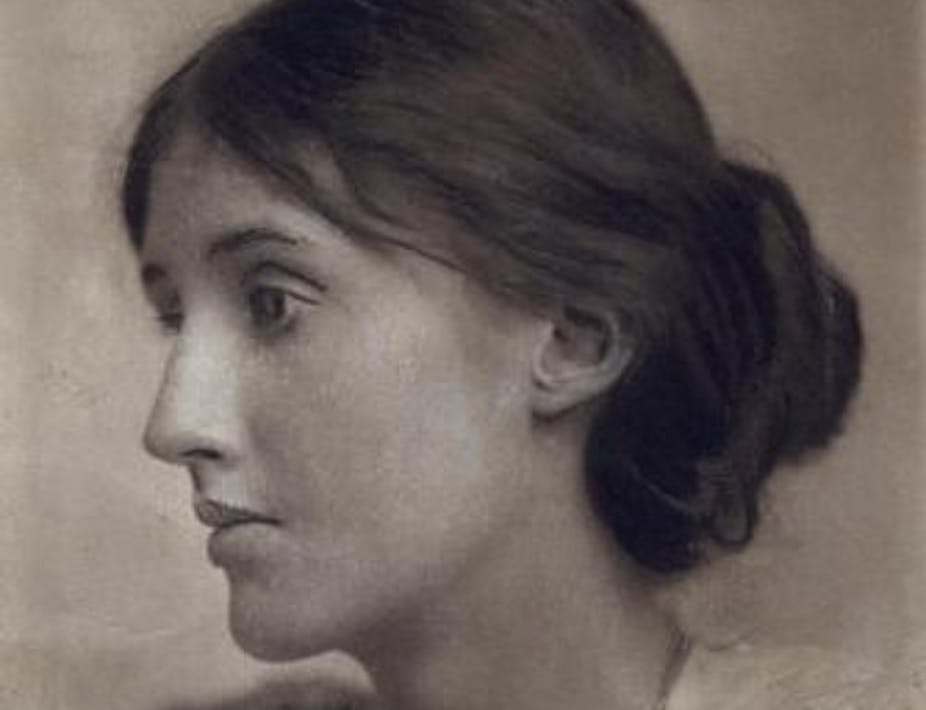The gorgeous, ethereal photographic portrait shot of Virginia Woolf taken in 1902 by George Beresford has become the iconic image of her, ubiquitous on mugs, mouse-mats and tea-towels.
This image certainly captures the 20-year-old Virginia Stephen’s delicate beauty, descended as she was from a line of famous beauties on her mother’s side. But it gives an all too simple impression of this complex and often contradictory writer.
The National Portrait Gallery’s exhibition Virginia Woolf: Art, Life and Vision reminds us of the immense significance of visual art to Woolf’s own practice, not least through her artist sister Vanessa Bell and the numerous visual artists within Woolf’s circle. But Woolf had an ambivalent attitude to having her own image captured.
While perfectly comfortable with informal snapshots – she grew up taking photographs of and being photographed by her siblings, and sustained her interest in amateur photography throughout her life – she hated being made to sit for professional portraits or photographs.

As she evocatively put it in response to the news that the photographer Gisèle Freund was to show the photographs she had taken of Woolf in June 1939, “I loathe being hoisted about on top of a stick for any one to stare at.”
Yet these photographs – as far as we know, the last professional pictures taken of Woolf before her death in 1941 – show Woolf, if not always altogether comfortable, at least now and then shooting the camera an ironic, even mischievous look.
Modernist masterpieces
Between the Beresford and the Freund portraits, formal photographs show Woolf in a variety of guises. Man Ray was able to persuade her to wear lipstick for a shoot in 1934 (she apparently forgot to remove it before she left the studio); the photographs he took show Woolf at her most recognisably avant-garde as well as most self-possessed. These high-contrast, dramatically lit photographs show her looking coolly and confidently directly at the camera; the angles and forms created by her position within the frame evoke the most abstract of modern visual art.
This is the Woolf of the modernist masterpiece, of Mrs Dalloway (1925) and To the Lighthouse (1927), of the extraordinary experimental short fiction from the 1919s and early 1920s collected in Monday or Tuesday (1921) and the sustained poetic prose of The Waves (1931). The fact that Man Ray had not, apparently, read any of Woolf’s work when he took these photographs perhaps indicates just how much Woolf’s image preceded her.
The image of Woolf in photographs taken for Vogue in 1924 is somewhat more ambiguous. Here we see her peering up from under a heavy fringe, looking elegant in (if somewhat too thin for) a late-19th century dress of her mother’s she chose to wear for the shoot. It might seem perverse for Woolf, already a celebrated literary innovator, to have adopted such an archaic costume – but the gesture maps perfectly onto her life and work.
A most detestable experience
The loss of her mother when she was 13 had an understandably devastating effect on the young Virginia, and her mother remained a pivotal figure in her psychic makeup throughout her life (despite Woolf’s somewhat disingenuous claim to have laid both her mother and father to rest in her mind through the writing of To the Lighthouse).

Also, notwithstanding her dramatic break with literary tradition, Woolf’s work kept up a dialogue with previous literary generations, albeit a sometimes antagonistic one. While her first two novels The Voyage Out (1915) and particularly Night and Day (1919) have more obvious continuities with the 19th century realist novel than her later work, at least in terms of style and technique, she continued to grapple with the legacy of the Victorian period throughout her oeuvre. Her penultimate novel The Years (1937), for example, is a family chronicle organised in chapters dated from 1880 to the present day.
Perversity with a purpose is a characteristic of Woolf’s work (and doubtless her character too), from the way she begins her polemical 1928 essay A Room of One’s Own with the grammatically frowned-upon “but”, to the reduction novelistic narrative convention almost to vanishing point in The Waves, to her composition of a fictional biography of Elizabeth Barrett Browning from the point of view of Browning’s spaniel, eponymously entitled Flush (1933).
Woolf may have felt that having her photograph taken was an experience “most detestable”. But her own knowledge, not to say shrewdness, about the process and impact of image-making should prompt particular attention to the images we have of her in her guise as an author.
Beresford may have captured Virginia Stephen as turn-of-the-century English rose; but portraits of Virginia Woolf, novelist, are as varied, striking and provocative as her body of work.

